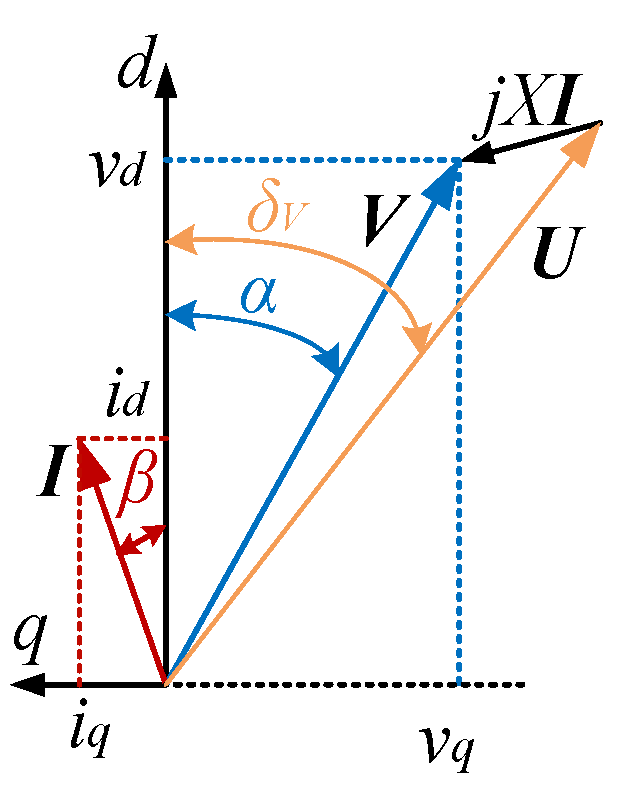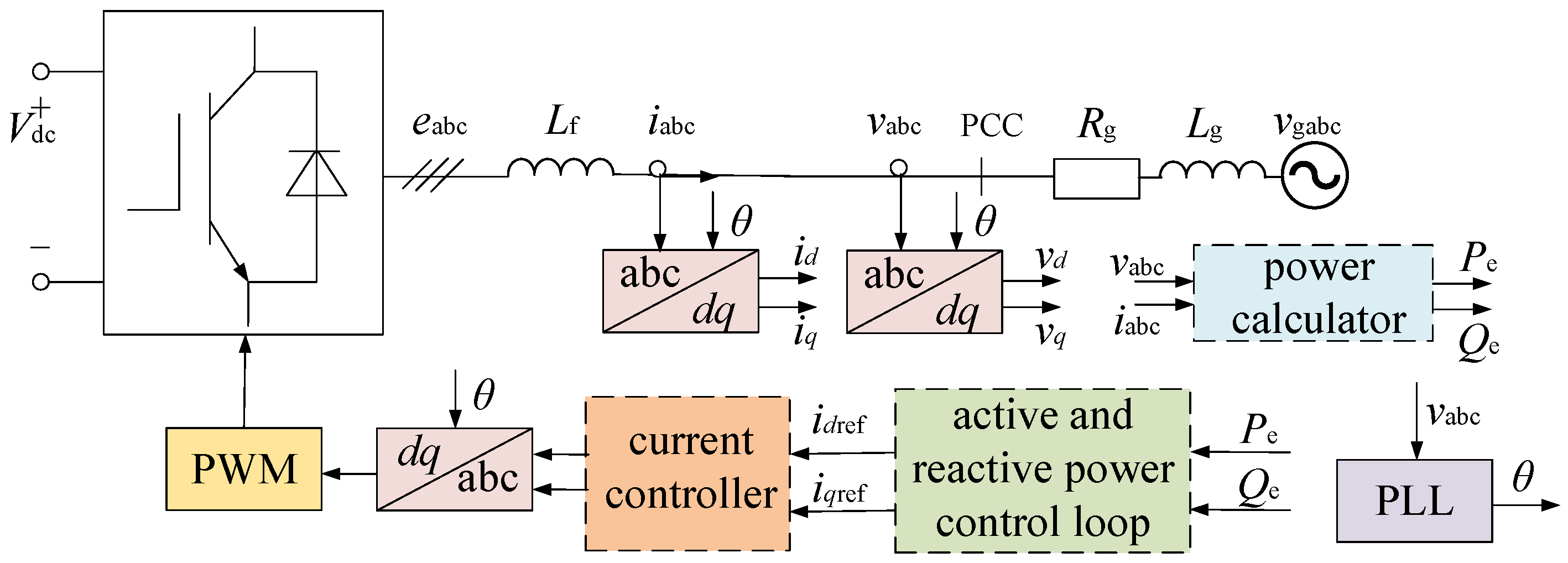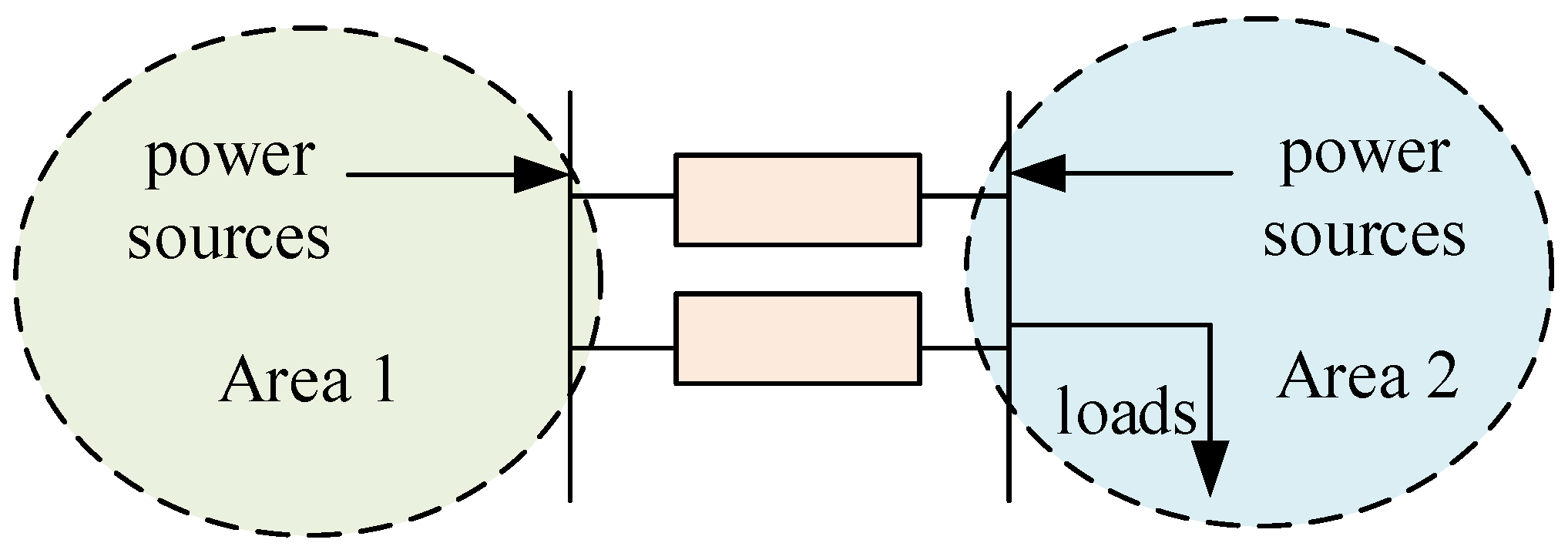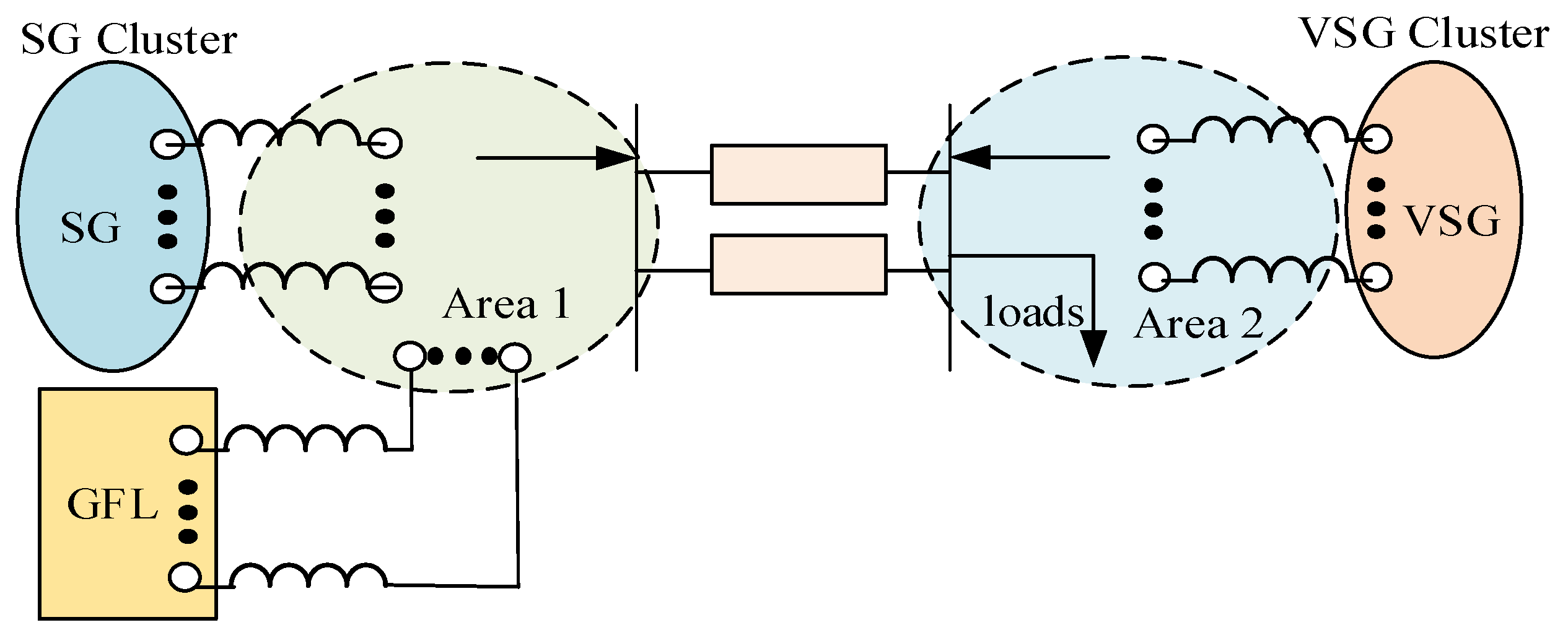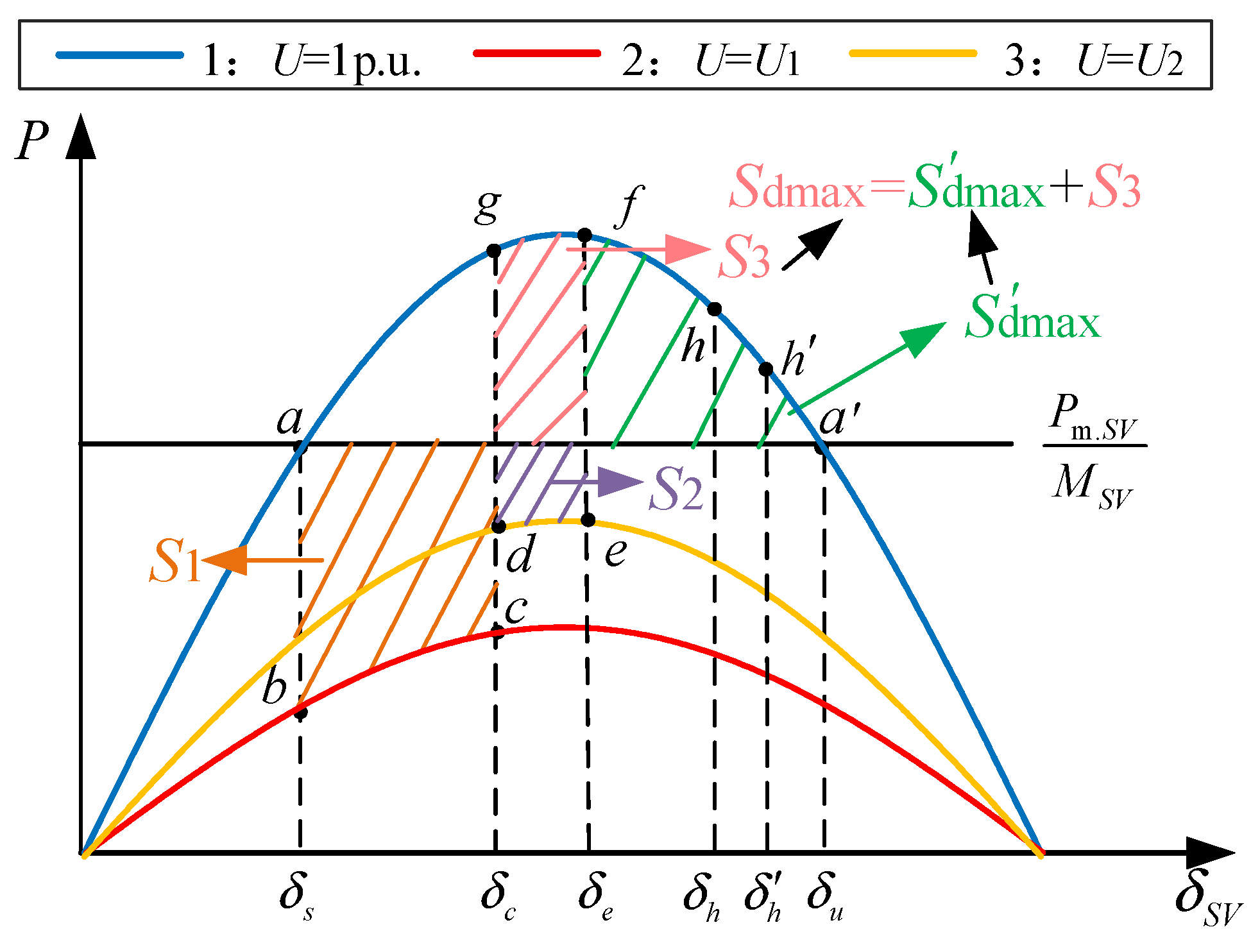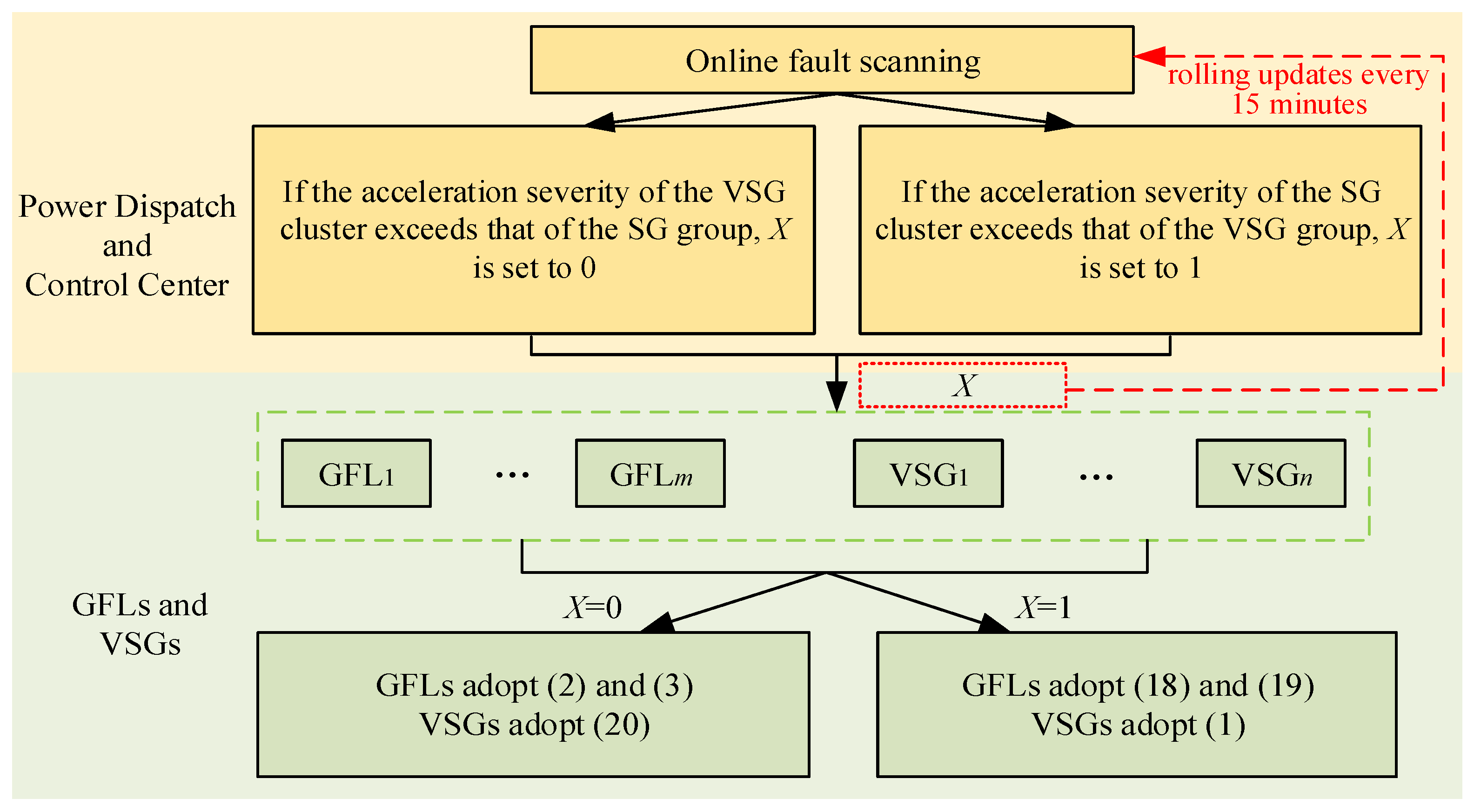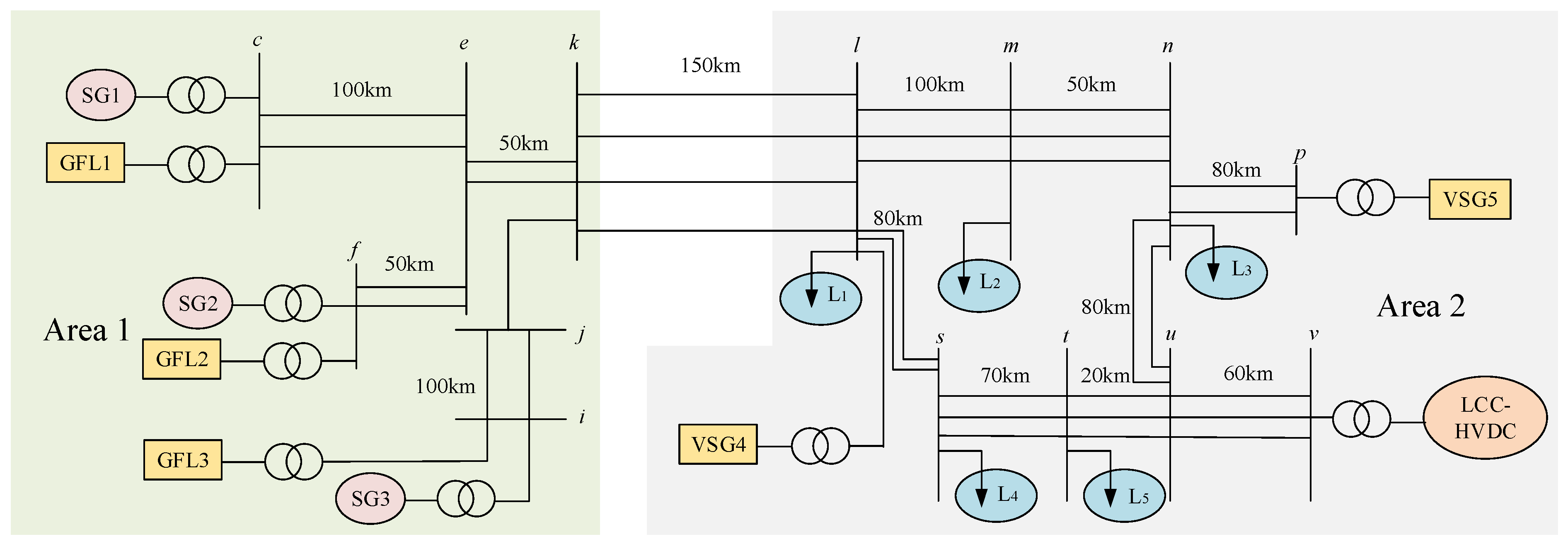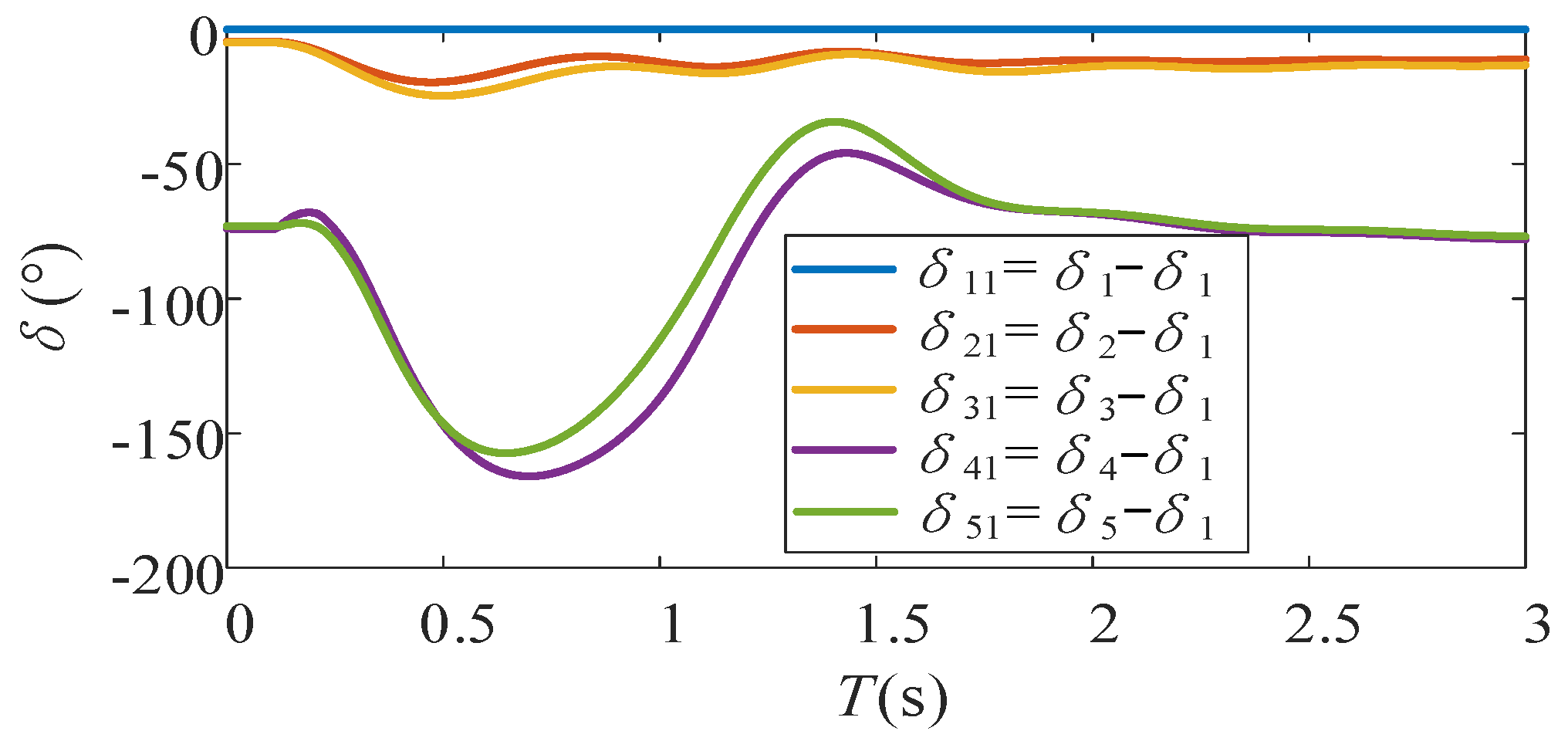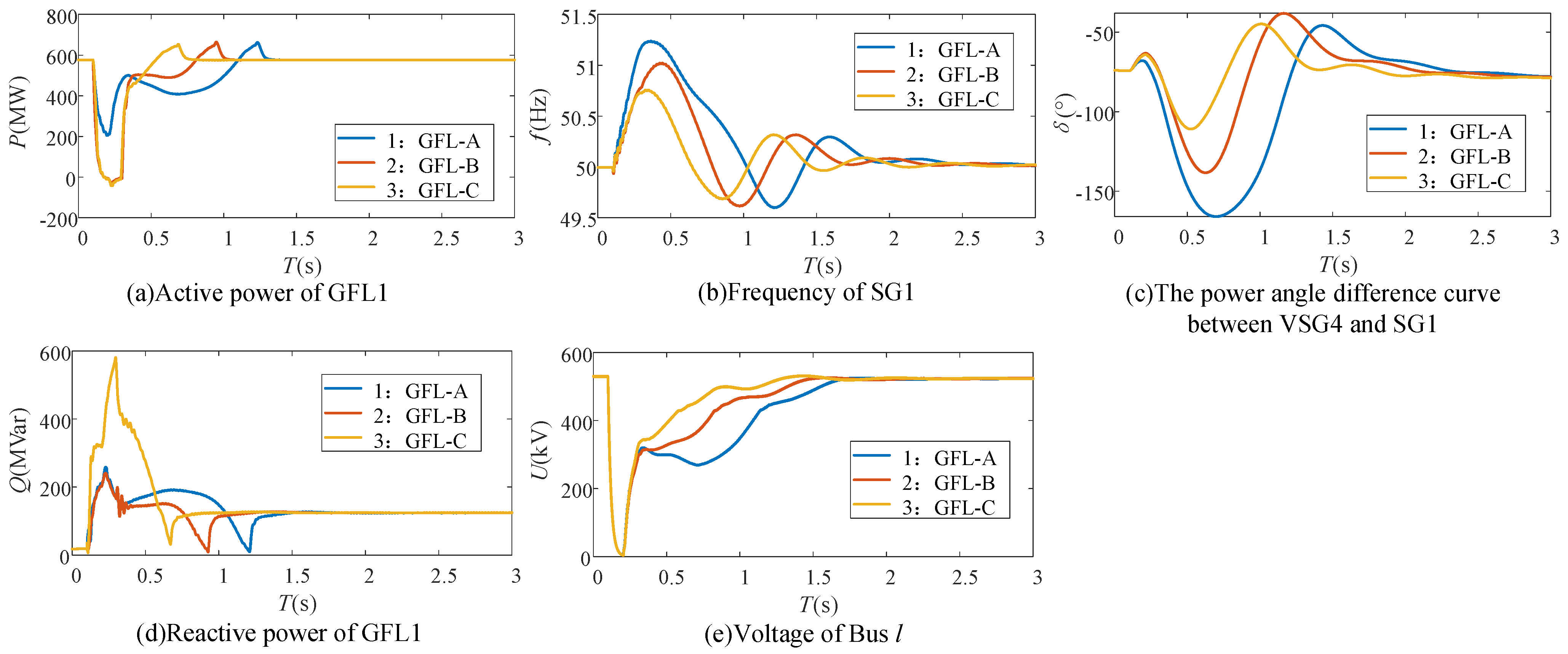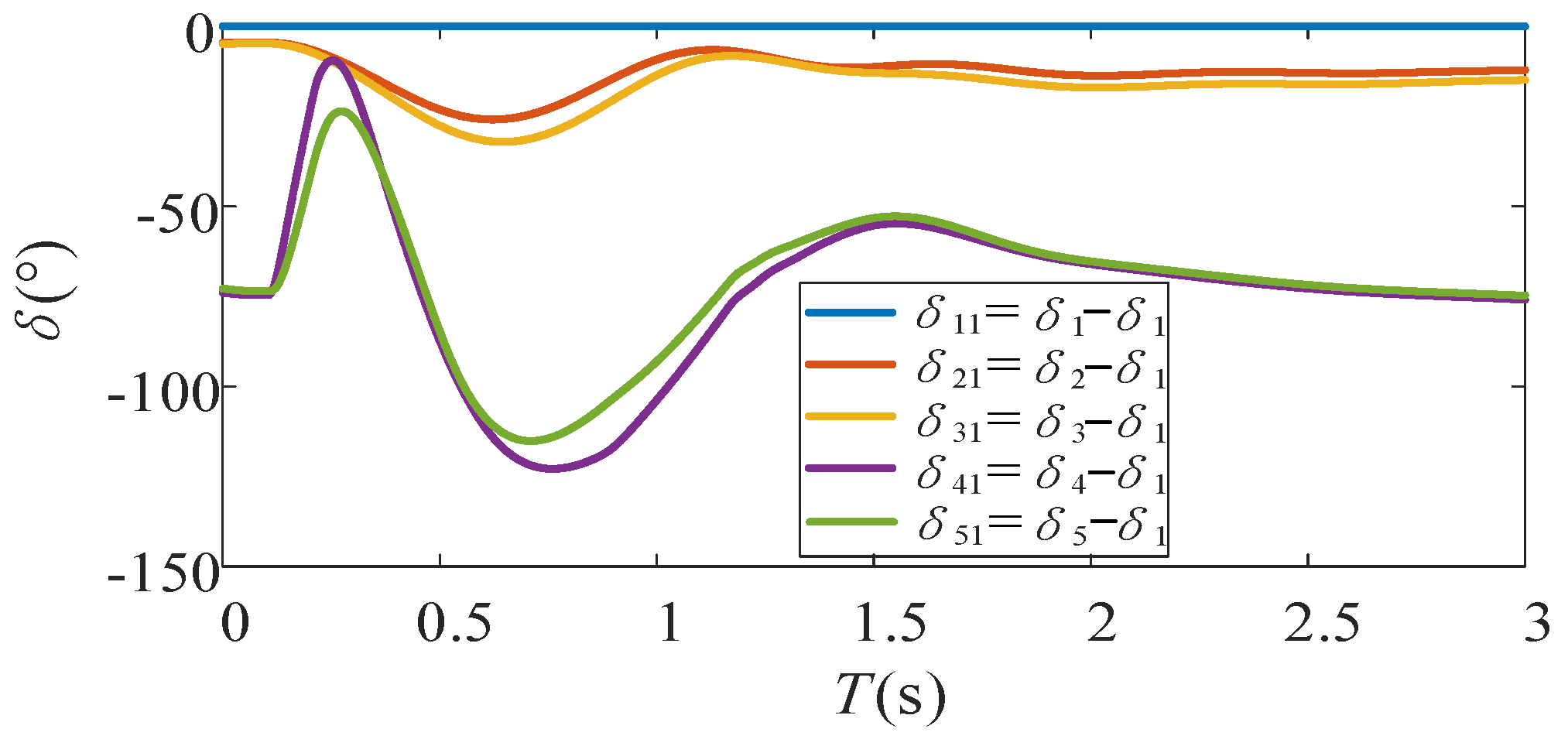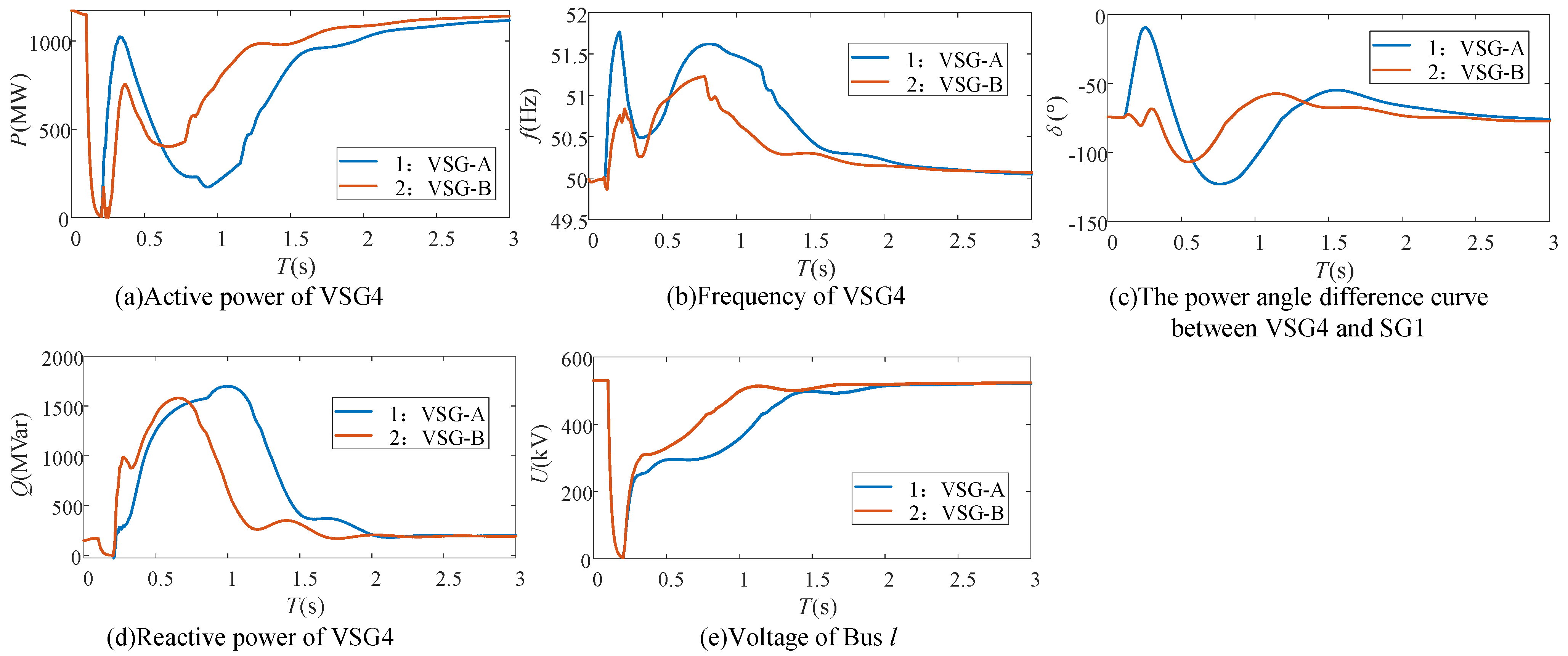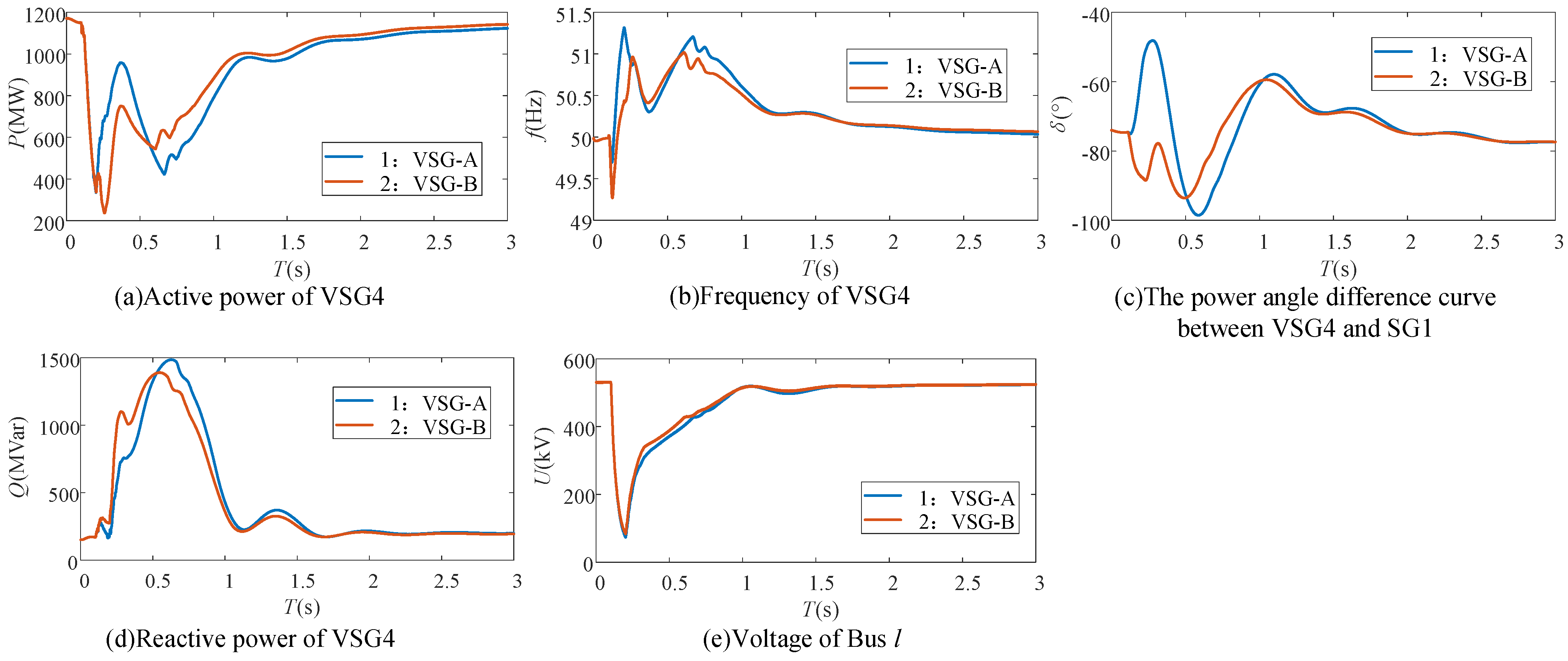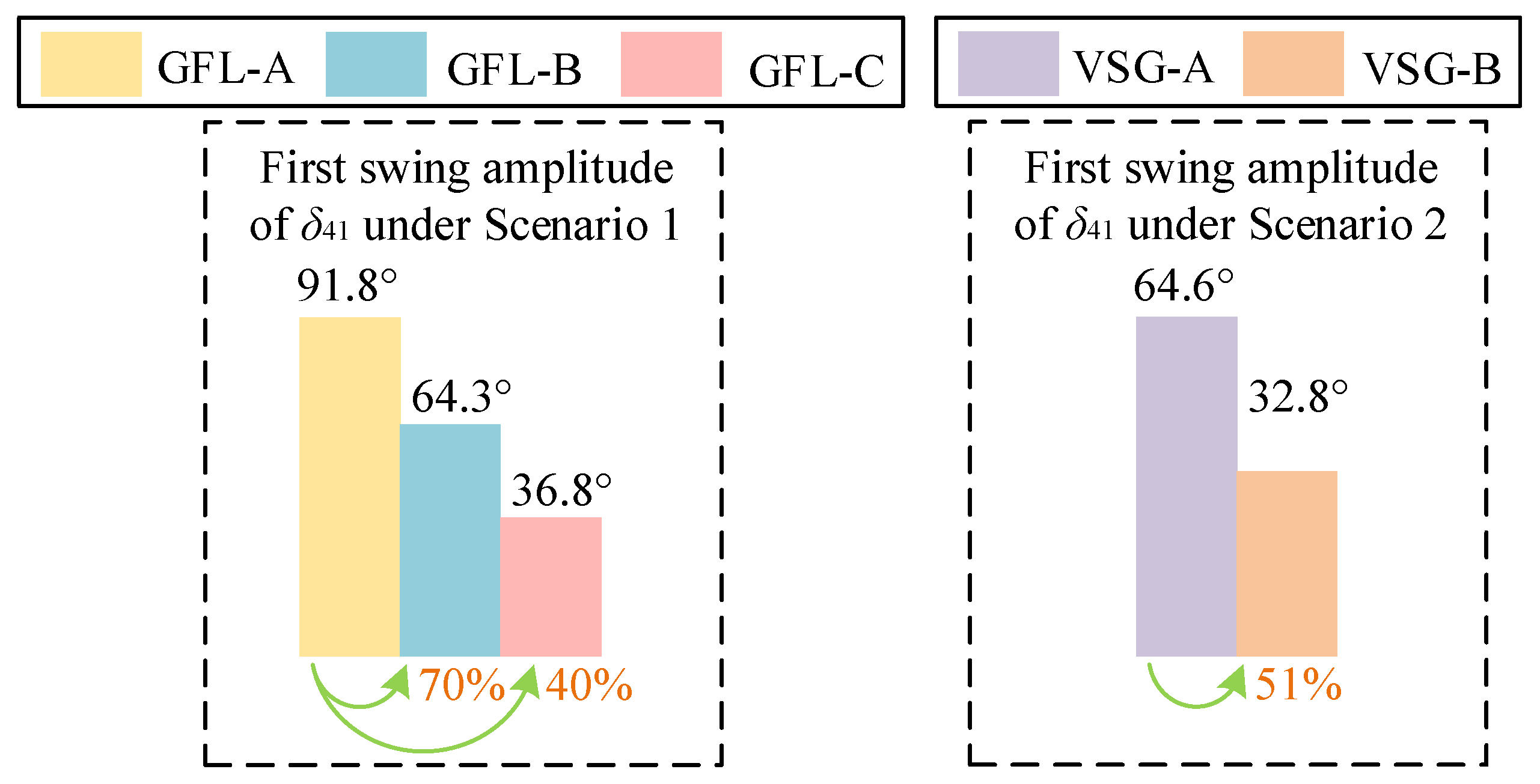1. Introduction
In recent years, the growing integration of renewable sources has led to an increasing share of voltage source converters (VSCs) in power grids [
1]. Consequently, the control strategies of VSCs are playing an increasingly critical role in determining the transient stability of modern power systems.
The control strategies for VSCs primarily include grid-following control (GFL) and grid-forming control (GFM) [
2]. The synchronization unit of GFL is the phase-locked loop (PLL). While it offers fast power response, enabling operation at maximum power points or dispatch setpoints, it inherently lacks active voltage and frequency regulation capabilities [
3]. In contrast, virtual synchronous generator (VSG) control, as a mainstream GFM approach [
4], can autonomously establish AC-side output voltage without dependence on external AC systems while actively participating in frequency and voltage regulation. However, this method typically requires multiple-fold overcurrent capability in design, resulting in poorer economic feasibility [
5]. Consequently, to balance both economic and stability requirements in power systems, both GFL and VSG technologies will play crucial roles in future grids with high penetration of power electronic converters.
With the increasing penetration of GFL and VSG converters, their impact on transient synchronous stability has attracted significant attention from researchers.
The transient synchronous stability mechanisms of power systems incorporating GFL converters have been extensively analyzed in [
6,
7,
8,
9]. Studies [
6,
7] demonstrated that the voltage drop occurring across grid impedance renders the point of common coupling (PCC) voltage susceptible to variations in the GFL inverter injection current, thereby inducing dynamic interactions between GFL converters and the main grid. These interactions have been recognized as the root mechanism leading to PLL desynchronization in GFL systems. Based on the equal-area criterion (EAC), investigations in [
8,
9] derived analytical expressions correlating the levels of GFL penetration with the power-angle disparities among synchronous generators (SGs). Their findings indicated that while initial increases in GFL penetration enhance synchronous stability between SGs, further penetration ultimately compromises it. Thus, an optimal level of GFL penetration exists that maximizes transient synchronous stability performance.
References [
10,
11,
12,
13] focus on the transient synchronous stability mechanisms in power systems incorporating VSG converters. Studies [
10,
11] employ EAC to elucidate the power-angle stability mechanism of VSG under large disturbances. Reference [
12] reveals that the transient switching operation mode (TSOM) induced by current saturation limits reduces the deceleration area and consequently degrades transient stability performance. Furthermore, reference [
13] investigates the transient loss-of-synchronization mechanism in VSG-SG hybrid systems based on the extended equal area criterion (EEAC), identifying the disparity between VSG and SG governor characteristics as a critical factor affecting transient synchronous stability.
In addition, leveraging the flexible and controllable nature of converters, numerous scholars have adapted the control strategies for GFL/VSG to enhance the synchronous stability of power systems.
Research efforts in [
14,
15,
16,
17] explore GFL control methods to strengthen transient synchronous stability. Specifically, refs. [
14,
15] enhance stability by boosting reactive power injection from GFL converters into the grid. Meanwhile, ref. [
16] introduces a novel GFL active power regulation strategy to mitigate power imbalance in adjacent synchronous generators (SGs). Additionally, ref. [
17] develops a coordinated approach combining double-fed induction generator active power adjustment with generator tripping control.
In [
10,
11,
18,
19,
20,
21,
22], the enhanced control strategies of VSG are discussed. In [
10], a flexible control strategy for VSG parameters is proposed to enhance the transient stability by adjusting damping coefficient and rotational inertia. In [
11], a mode-adaptive power angle control is proposed to prevent the VSG-based system from collapsing due to the delayed fault clearance or the malfunction of protective relays. In [
18], the transient power angle acceleration of VSG is suppressed by adjusting the active power command value. In [
19], an anti-windup stability enhancement control strategy is proposed to maintain the normal unsaturated mode of the VSG while ensuring transient stability. In [
20], an equal proportional area criterion is introduced to guide the design of VSG control, along with an adaptive strategy for adjusting inertia and damping. In [
21], an active power dispatch method aimed at minimizing transient instability risk is proposed. In [
22], an adaptive power angle compensation algorithm is developed to improve transient synchronous stability.
In summary, the aforementioned studies have substantially advanced the analysis and control of synchronous stability in power systems incorporating VSG or GFL converters. Nevertheless, two major research gaps persist. First, the underlying mechanisms through which converter distribution and voltage stability affect synchronous stability have not been systematically investigated. Second, while existing enhanced control strategies have been developed for either VSG-SG or SG-GFL systems, there is a notable absence of comprehensive control solutions specifically designed for hybrid VSG-GFL-SG systems due to the complex coherency grouping and strong coupling among multiple types of power sources. Therefore, the contributions of this paper are as follows.
(1) Building upon the analysis of the distinct capabilities of different power sources in reshaping synchronous stability, this paper proposes a novel distribution scheme for VSG, GFL, and SG units to simplify stability analysis and control in future grids with high penetration converters. The proposed scheme strategically locates SGs and GFL converters at the power sending area while locating VSG units at the power receiving area. Under the scheme, transient synchronous stability is determined by the power angle difference between VSGs and SGs.
(2) Based on EEAC, this study analytically examines how the voltage stability affects the synchronous stability between SGs and VSGs. The research reveals that voltage stability and synchronous stability are positively correlated.
(3) Under the proposed distribution scheme of power supplies, this paper develops enhanced control strategies for VSG and GFL converters to regulate their transient active/reactive power response characteristics, thereby enhancing the voltage stability and the synchronous stability between SGs and VSGs.
The rest of the paper is organized as follows:
Section 2 introduces the classical control structures of VSG and GFL converters, and the two-area interconnection system. The mechanism analysis is discussed in
Section 3.
Section 4 proposes enhanced GFL and VSG control strategies.
Section 5 validates the mechanism analysis and the proposed control strategy through PSCAD.
Section 6 summarizes the conclusions.
4. The Enhanced Control Strategies
Building upon the mechanistic analysis presented in
Section 3, this section proposes enhanced control strategies for GFL and VSG to improve the transient voltage stability and transient synchronous stability.
4.1. The Enhanced Control of GFL
When the acceleration severity of the SG cluster exceeds that of the VSG group after a fault occurs, measures should be taken to suppress the rotor acceleration of SGs, thereby reducing the power angle difference between SGs and VSGs and enhancing synchronous stability. Based on the analysis in
Section 3.1.2, reducing the active power output of GFL converters proves effective in restraining the rotor acceleration of SGs.
Accordingly,
idref can be adjusted as
During low-voltage conditions when SGs experience the most significant acceleration, the active power reference of GFL converters is set to zero according to (18) to maximally suppress rotor acceleration in SGs.
Furthermore, building upon the analysis in
Section 3.2, it is essential to increase the reactive power output of GFL converters to improve both voltage stability and synchronous stability. Consequently, the q-axis current reference for the GFL converter should be determined as follows:
Compared with (2), (19) increases the amplification factor of the voltage difference, thereby enhancing the reactive power support capability of GFL converters.
If the accelerated motion of the SGs is the primary cause of the power angle separation between VSGs and SGs, synchronous stability can be improved solely by adjusting GFL converters to modify the SGs’ rotor dynamics, while maintaining conventional control strategies for VSGs.
It should be noted that the capacity ratio between GFL converters and SGs influences the degree of impact that GFLs exert on SGs, thereby affecting the efficacy of GFL control strategies in enhancing the synchronous stability between VSGs and SGs.
4.2. The Enhanced Control of VSG
When the acceleration severity of the VSG cluster exceeds that of the SG group after a fault occurs, measures should be taken to suppress the rotor acceleration of VSGs, thereby reducing the power angle difference between SGs and VSGs and enhancing synchronous stability.
Therefore, the active power control loop of VSG can be adjusted as
where
Pref0 is the steady-state command value of VSG active power.
UPCC is the voltage amplitude of PCC in
Figure 1.
Based on (20), when voltage sag occurs and the VSG rotor accelerates, Pref will decrease to suppress the VSG’s acceleration. As voltage recovers, Pref will gradually return to its steady-state value.
Interestingly, (20) also enhances the reactive power support capability of VSG, with the underlying mechanism operating as follows.
During voltage sags, VSG increases the reactive power injected into the power grid, which means the
q-axis current of VSG is negative and its absolute value increases. As evident from the voltage loop structure in
Figure 1,
vq is greater than 0, which means
V is ahead of the
d-axis based on
Figure 2. If
Pref is reduced through (20), the rotational speed of the
d-axis will slow down and
vq will increase based on
Figure 2. According to the voltage loop structure, the absolute value of
iq will also increase, thereby increasing the reactive power output of VSG.
If the accelerated motion of the VSGs is the primary cause of the power angle separation between VSGs and SGs, synchronous stability can be improved solely by adjusting VSG converters, while maintaining classical control strategies for GFLs.
As evidenced by the preceding analysis, when the accelerated motion of the SGs is the primary cause of the power angle separation between VSGs and SGs, GFL inverters should adopt the enhanced control strategy specified in (18) and (19), while VSGs maintain the classical control strategy outlined in (1). Conversely, when the accelerated motion of the VSGs is the primary cause of the power angle separation between VSGs and SGs, GFL should revert to the classical control strategy governed by (2) and (3), whereas VSGs implement the enhanced control approach prescribed in (20).
However, in practice, how can the acceleration severity of VSG and SG clusters under large disturbances be determined in advance to select appropriate control strategies?
To address this challenge, this paper proposes the control framework of
Figure 8.
Under this control framework, the power dispatch and control center performs fault simulations every 15 min. The simulated fault is located at the load side of the long AC interconnection corridor in the two-area system, with the fault type being a three-phase short-circuit with zero grounding resistance. After 0.1 s of fault duration, circuit breakers on both ends of the line trip. Based on the simulation results, the acceleration severity of VSG and SG clusters under a large disturbance in the current operational scenario can be identified. If the acceleration severity of the VSG cluster exceeds that of the SG group after a fault occurs, the parameter X is set to 0; otherwise, X is set to 1. Then, X is broadcast to all GFLs and VSGs, enabling them to predetermine their control strategies under large disturbances.
The proposed control architecture relies on rolling updates every 15 min rather than real-time communication, making it less susceptible to delays in real-time data transmission.
5. Case Studies
The simplification system of an actual grid is shown in
Figure 9. The simulation is based on the PSCAD platform.
The power sending area (Area 1) delivers power to the load center (Area 2). The loads (L
1, L
2, L
3, L
4, and L
5) are modeled as a hybrid configuration, with 70% of the load constituting constant impedance and the remaining 30% represented by dynamic induction motor models. The total active power of loads is 9,000 MW. For more details of this system, refer to [
25]. For GFL,
Pref = 0.8 p.u.,
Uref = 1.03 p.u.,
Kpll = 50,
Tpll = 0.01 s,
imax = 1.0 p.u., and
kp = 0,
ki = 33.3. For VSG,
Pref = 0.8 p.u.,
Qref = 0.2 p.u.,
MV = 0.1,
K = 0.06,
Dq = 10, and
Ilim = 2.0 p.u. It should be noted that all parameters of the GFL converters in
Figure 9 are identical, and similarly, all parameters of the VSG units are uniformly configured. The values of
Pref,
Qref,
Uref,
imax, and
Ilim can be configured according to specific application requirements, while the values of the remaining parameters in this paper are consistent with those in the GFL and GFM converter models provided on the official PSCAD platform.
Based on
Figure 9, Scenario 1 is as follows.
The numbers for SG1, SG2, and SG3 are 2, 2, and 2. The rated capacity and inertial time constant of each SG are 360 MVA and 4 s. The active power of each SG is 288 MW. The active power of the line-commutated converter-based high-voltage DC (LCC-HVDC) is 3000 MW. The active powers of GFL1, GFL2, and GFL3 are 576 MW, 576 MW, and 800 MW. The active powers of VSG4 and VSG5 are both 1152 MW. The damping coefficient D of each VSG is 70.
To simulate diverse first-swing power angle separation behaviors between VSGs and SGs, Scenario 2 is derived from Scenario 1 by modifying two parameters: the inertial time constant of each SG is increased to 6 s, and the damping coefficient of each VSG is adjusted to 20.
To study the transient synchronous stability, two distinct fault locations, denoted as Fault 1 and Fault 2, are defined as follows.
Fault 1: A three-phase fault is applied to the l side of one kl line at t = 0.1 s. The fault is then cleared by isolating the affected line at t = 0.2 s.
Fault 2: A three-phase fault is applied to the k side of one kl line at t = 0.1 s. The fault is then cleared by isolating the affected line at t = 0.2 s.
5.1. Scenario 1
Under the condition that both VSGs and GFLs adopt classical control strategies, the power angle difference curve of Scenario 1 and Fault 1 is obtained, as shown in
Figure 10.
Here, δ1, δ2, and δ3 represent the power angle of SG1, SG2, and SG3. δ4 and δ5 represent the virtual power angle of VSG4 and VSG5.
As illustrated in
Figure 10, the acceleration severity of the SG cluster exceeds that of the VSG group after a fault occurs. Therefore, according to
Section 4, GFLs should adopt the enhanced control strategy, while VSGs maintain the classical control strategy.
Three distinct modes are implemented to validate the efficacy of the proposed GFL control strategy, which is shown in
Table 3.
The simulation results of GFL-A, GFL-B, and GFL-C under Scenario 1 and Fault 1 are shown in
Figure 11.
(1) As evidenced by curves 1 and 2 in (a), (b), and (c), GFL inverters can effectively suppress rotor acceleration of adjacent SGs by reducing their active power output during low-voltage periods. This mitigation strategy consequently reduces the power angle difference between SGs and VSGs in Scenario 1 (where the acceleration severity of the SG cluster exceeds that of the VSG group after a fault occurs), thereby enhancing the transient synchronous stability. These results not only validate the mechanistic analysis presented in
Section 3.1.2, but also demonstrate the efficacy of the enhanced GFL control strategy proposed in
Section 4.1.
(2) As observed from Curves 2 and 3 in (c), (d), and (e), the GFL inverters enhance their reactive power support capability by increasing the
q-axis current reference value, which accelerates the voltage recovery and consequently improves the transient synchronous stability. These findings corroborate the validity of the mechanistic analysis in
Section 3.2 and demonstrate the effectiveness of the enhanced GFL control strategy proposed in
Section 4.1.
The simulation results of GFL-A, GFL-B, and GFL-C under Scenario 1 and Fault 2 are shown in
Figure 12.
A comparison between
Figure 11 and
Figure 12 confirms the effectiveness of the proposed theoretical analysis and control enhancements under different fault scenarios.
5.2. Scenario 2
Under the condition that both VSGs and GFLs adopt classical control strategies, the power angle difference curve of Scenario 2 and Fault 1 is obtained, as shown in
Figure 13.
In
Figure 13,
δ1,
δ2, and
δ3 represent the power angle of SG1, SG2, and SG3.
δ4 and
δ5 represent the virtual power angle of VSG4 and VSG5.
As illustrated in
Figure 13, the acceleration severity of the VSG cluster exceeds that of the SG group after a fault occurs. Therefore, according to
Section 4, GFLs should revert to the classical control strategy, whereas VSGs implement the enhanced control approach.
Two distinct modes are implemented to validate the efficacy of the proposed VSG control strategy, which is shown in
Table 4.
The simulation results of VSG-A and VSG-B under Scenario 2 and Fault 1 are shown in
Figure 14.
(1) As demonstrated by Curves 1 and 2 in (a), (b), and (c), VSGs can effectively suppress their own virtual rotor acceleration through adaptive regulation of the active power reference value
Pref. This control approach significantly reduces the power angle difference between VSGs and SGs in Scenario 2 (where the acceleration severity of the VSG cluster exceeds that of the SG group after a fault occurs), thereby enhancing the transient synchronous stability. These results not only validate the mechanistic analysis presented in
Section 3.1, but also demonstrate the efficacy of the enhanced VSG control strategy proposed in
Section 4.2.
(2) As evidenced by Curves 1 and 2 in (c), (d), and (e), the reduction in active power reference values in VSGs enhances their reactive power support capability. This control modification accelerates voltage recovery and consequently improves the transient synchronous stability. These findings corroborate the validity of the mechanistic analysis in
Section 3.2 and demonstrate the effectiveness of the enhanced VSG control strategy proposed in
Section 4.2.
The simulation results of VSG-A and VSG-B under Scenario 2 and Fault 2 are shown in
Figure 15.
A comparison between
Figure 14 and
Figure 15 confirms the effectiveness of the proposed theoretical analysis and control enhancements under different fault scenarios.
To quantitatively assess how enhanced control strategies for VSGs and GFLs improve synchronous stability,
Figure 16 presents the first-swing amplitude of the power angle difference between VSG4 and SG1 across various scenarios and control modes. For brevity, only the results under Fault 1 are presented and analyzed.
Where
δ41 is the power angle difference between VSG4 and SG1 corresponding to
Figure 11c and
Figure 14c.
(1) Under the proposed d-axis current control for GFL, the first-swing amplitude of δ41 decreased by 30%, while under the full enhanced GFL control, a reduction of 60% was achieved.
(2) Under the enhanced VSG control, the first-swing amplitude of δ41 decreased by 49%.
6. Conclusions
Based on the analysis of the distinct capabilities of different power sources in reshaping synchronous stability, this paper proposes a novel distribution scheme for VSGs, GFLs, and SGs to simplify synchronous stability analysis and control in future high-converter-penetration power grids. Within this framework, we systematically investigate the mechanistic influence of voltage stability on power angle stability between SGs and VSGs. Building on these insights, enhanced control strategies for both VSGs and GFL converters are developed. The conclusions include the following:
(1) VSGs can flexibly adjust the control parameters to directly reshape synchronous stability. In contrast, by tuning the control parameters to alter the rotor dynamics of nearby SGs, GFLs can indirectly influence synchronous stability.
(2) The proposed scheme strategically locates SGs and GFL converters at the power sending area while locating VSG units at the power receiving area. Under the scheme, transient synchronous stability is determined by the power angle difference between VSGs and SGs.
(3) A weaker voltage stability corresponds to a larger acceleration area and a smaller maximum deceleration area in the system, thereby degrading the transient synchronous stability.
(4) The enhanced control strategies for VSGs and GFLs are proposed to improve the voltage stability and the synchronous stability between SGs and VSGs.
It should be acknowledged that the validation in this study is based on simulations conducted on the PSCAD platform, which lacks verification through physical hardware tests or real systems. Additionally, this research is confined to a two-area interconnected system, necessitating further expansion to more complex grid topologies. These aspects represent important directions for future work.

